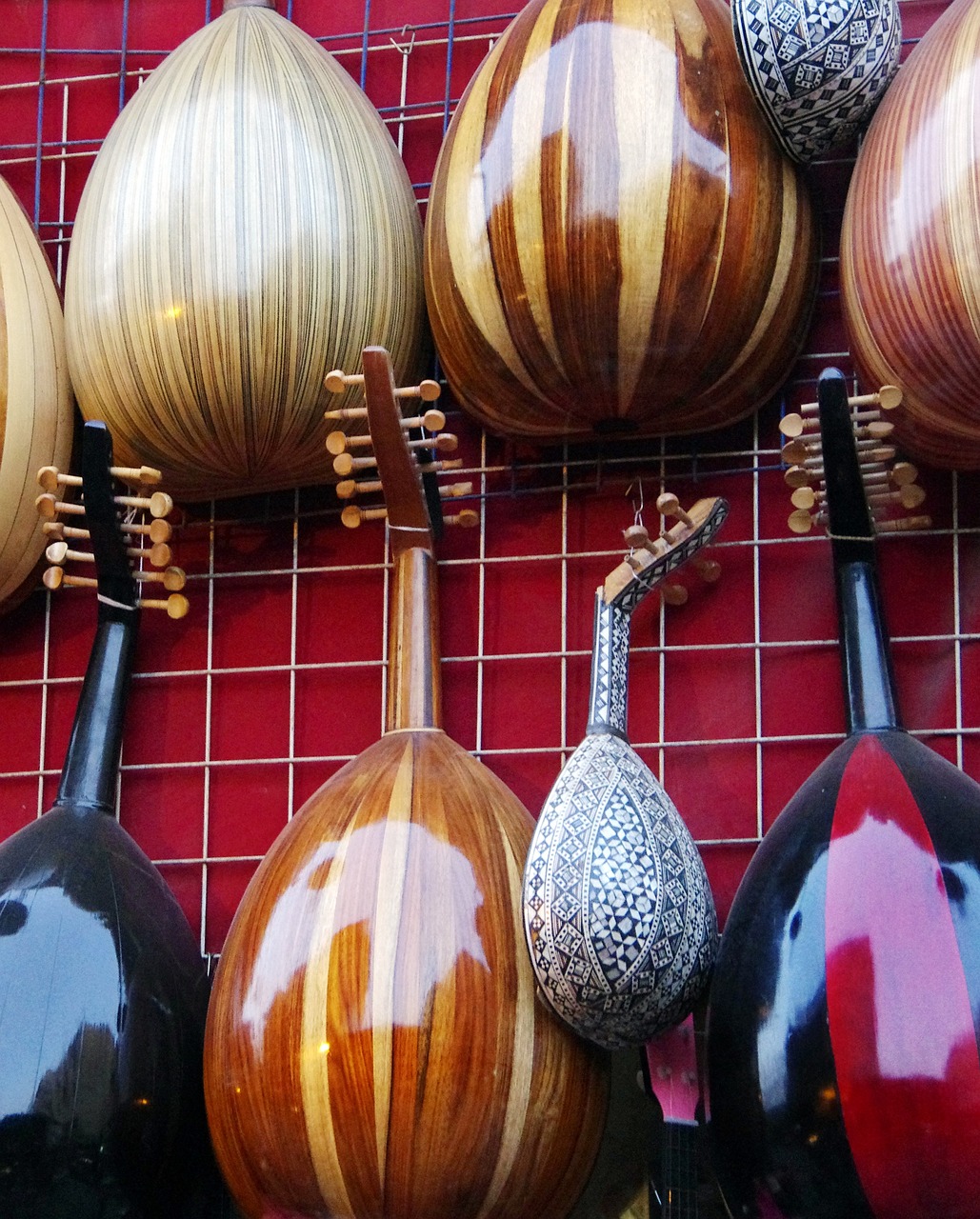
The Oud: A Musical Gem
The Oud, a timeless and enchanting musical instrument, has graced the world of music for centuries. With its roots deeply embedded in the Arab and Muslim world, it has been considered one of the most captivating instruments, serving as a melodic bridge between cultures and traditions.
But what makes the Oud truly exceptional is not just its rich history; it’s the enchanting sounds it produces. The Oud has a unique ability to convey deep emotions, telling stories through every note it plays. It’s a beloved instrument in various styles and genres, from classical to contemporary and from the Mediterranean to Central Asia, thanks to its versatility and soulful timbre.
But to unlock the Oud’s true potential and harness its mesmerizing power, there’s one crucial element that every Oud player must master: tuning. Proper tuning is the key to bringing out the Oud’s exquisite tones and ensuring that its melodies resonate with clarity and beauty.
This article will explore the art of tuning the Oud, exploring the intricacies of achieving the best possible tuning. We’ll provide you with valuable insights, techniques, and tips to help you make your Oud sound its best, allowing you to create music that touches the heart and soul.
So, let’s embark on this musical journey, where every note is certain to resonate with the harmony of the Oud itself.
Understanding Oud Tuning
When it comes to playing the Oud, understanding its tuning is fundamental. Let’s dive into the basics of Oud tuning, which includes the number of strings and tuning pegs, as well as the most common Oud tunings like Syrian known as the classical tuning, Iraqi, and Turkish.
Basics of Oud Tuning:
Number of Strings: The Oud typically features 11 or 12 strings. These strings are paired together, creating courses. The most common configuration is five pairs of strings and one single low-pitched string, but some variations may have different arrangements.
Tuning Pegs: Oud tuning pegs are used to adjust the tension and pitch of the strings. These pegs are crucial for achieving the desired tuning. Tuning the Oud involves turning these pegs to tighten or loosen the strings until they reach the desired pitch.
Common Oud Tunings:
Classical or Syrian Tuning (C2 F2 A2 D3 G3 C4): This is one of the most widely used tunings for the Oud. It consists of six courses of strings, with each course tuned to a specific note. Starting from the highest-pitched course, the tuning is C2 F2 A2 D3 G3 C4. This tuning is commonly used in Arabic and Middle Eastern music.
Turkish Tuning (C#2 F#2 B2 E3 A3 D4): Turkish tuning is another prevalent tuning for the Oud. Like Arabic tuning, it also has six courses of strings. The tuning for Turkish Oud is C#2 F#2 B2 E3 A3 D4. Turkish tuning is often favored in Turkish and Mediterranean music traditions.
These tunings provide a unique character to the Oud’s sound, allowing musicians to explore various musical styles and genres. Choosing the right tuning depends on the musical context and personal preference.
Understanding Oud tuning is the first step in mastering this captivating instrument. Whether you’re drawn to the mesmerizing melodies of Arabic or Turkish music, a solid grasp of Oud tuning is essential for creating beautiful music.
Tools and Techniques for Tuning

Tuning the Oud effectively requires the right tools and a systematic approach. Here, we’ll describe the essential tools you’ll need and provide step-by-step instructions on how to tune each string of the Oud, with visual aids available in online resources.
Essential Tools for Oud Tuning:
Oud Tuner: An Oud tuner is a specialized electronic device designed to help you accurately tune your Oud. These tuners can detect the pitch of each string and provide real-time feedback, making the tuning process precise and efficient.
Tuning Pegs: Tuning pegs are located on the headstock of the Oud. They are used to adjust the tension of each string individually. Turning the pegs clockwise tightens the string and raises its pitch, while turning counterclockwise loosens the string and lowers its pitch.
Tuning Key: A tuning key, also known as a peg winder, is a handy tool for turning the tuning pegs more easily and quickly. It provides additional leverage, making the fine adjustments needed for tuning.
Step-by-Step Oud Tuning Instructions:
- Prepare Your Oud: Make sure your Oud is in a stable and comfortable position on your lap or with suitable support. The Oud also needs to be clean and free from any debris that could affect the tuning.
- Select Your Tuning: Decide on the tuning you want to use based on your musical preferences. Common tunings include Syrian or Classical tuning (C2 F2 A2 D3 G3 C4) and Turkish tuning (C#2 F#2 B2 E3 A3 D4).
- String by String: Start with the highest-pitched string, which is typically the single string. Use your Oud tuner to determine the current pitch of the string.
- Adjust the Peg: Turn the corresponding tuning peg in the direction needed to match the desired pitch for that string. Use small, gentle movements, as Oud strings can be delicate.
- Repeat for Each String: Continue this process for each string, moving from the highest to the lowest pitch. Use your Oud tuner to guide you and ensure accuracy.
- Check and Fine-Tune: After tuning all strings, go through them again to double-check their pitch. Make any necessary adjustments until each string is in tune.
Remember that tuning an Oud may take some practice to get it just right. It’s important to be patient and gentle with the strings and pegs. Utilize the visual aids available in online resources to assist you in this process, as they can provide a clear visual reference for tuning your Oud effectively.
Common Tuning Problems
Tuning the Oud can sometimes be tricky, and Oud players may encounter common issues that can disrupt the tuning process. Here, we’ll highlight these problems, provide solutions, and provide practical guidance from video resources.
Peg Slippage:
Problem: Peg slippage is a common issue where the tuning pegs fail to hold the tension of the strings, causing them to go out of tune.
Solution: To prevent peg slippage, you can try the following:
Peg Compound: Apply a small amount of peg compound or peg dope to the pegs. This substance provides friction and helps the pegs grip the strings better, reducing slippage.
Push and Turn: When tuning, push the peg inward while turning it. This helps to set the peg in place more securely.
String Winding: Make sure the strings are wound neatly around the pegs. Messy winding can contribute to slippage.
For practical guidance on addressing peg slippage, you can refer to video tutorials, which often demonstrate these techniques visually.
By understanding and addressing common tuning problems like peg slippage, Oud players can enjoy a smoother and more enjoyable tuning experience, ensuring that their instrument produces beautiful and harmonious melodies.
Optimizing Oud Sound
To achieve the best sound from your Oud, consider the following tips:
Adjusting String Tension:
String tension plays a crucial role in the Oud’s sound quality. Experiment with different string tensions to find your preferred balance between playability and tone. Start with lower tension strings and gradually work your way up until you achieve the desired sound. This process allows you to discover the tension that suits your playing style and musical preferences.
Selecting the Right Strings:
Choosing the right strings for your Oud can significantly impact its sound. Various types of Oud strings are available, each producing distinct tones. Arabic and Turkish Oud strings, for instance, have different characteristics.
Consult with experienced players or music stores specializing in traditional instruments to find the strings that match your musical goals.
Expert Advice:
For more in-depth guidance on optimizing Oud sound quality, you can refer to expert advice and tutorials available online. These resources often provide valuable insights, techniques, and demonstrations from experienced Oud players, helping you enhance your Oud’s sound and musical expression.
By adjusting string tension and selecting the right strings, you can unlock the full potential of your Oud and create beautiful, resonant melodies that captivate your audience.
Exploring Different Tunings

The Oud is a versatile instrument with a rich history, and its tunings vary across different musical traditions. Here are some alternative Oud tunings used in various musical traditions and the reasons behind their choices:
Classical or Syrian Tuning (C2 F2 A2 D3 G3 C4):
Traditional Arabic Music: This tuning is commonly used in traditional Arabic music. It provides a deep and resonant sound, suitable for Arabic music’s melodic and improvisational nature.
Turkish Tuning (C#2 F#2 B2 E3 A3 D4):
Classical Turkish Music: Turkish tuning is prevalent in classical Turkish music. The higher pitch and bright tone make it ideal for Turkish compositions’ intricate and ornamented melodies.
Iraqi Tuning (F2 A2 D3 G3 C4 F4):
Iraqi Maqam Music: Iraqi tuning is favored in Maqam music of Iraq. It offers a unique tonal palette for intricate Maqam scales and emotive improvisations.
Persian Tuning (D2 E2 A2 D3 G3 A3):
Persian Classical Music: Persian tuning suits the microtonal nuances of Persian classical music. It allows musicians to explore quarter-tones and create subtle melodic shifts.
Experimental Tunings:
Contemporary and Experimental Music: Some Oud players experiment with non-traditional tunings to push the boundaries of the instrument and create new sounds. These tunings are chosen to achieve specific avant-garde effects.
Oud players select different tunings based on the musical style they are performing and the emotional expression they seek to convey. The choice of tuning can affect the instrument’s tonal quality, range, and melodic possibilities. It allows musicians to capture the essence of their musical tradition and adapt to the demands of specific compositions, creating a diverse and dynamic Oud repertoire.
Final Thoughts on Tuning The Oud
Tuning the Oud is a fundamental aspect of mastering this captivating instrument. To achieve the best possible sound, here are the key takeaways:
Precision is Key: Use a reliable tuner to ensure your Oud is accurately tuned. Start by tuning the top high string and then match the others to it for consistent tuning.
Experiment and Explore: Oud enthusiasts should embrace experimentation. Different tunings offer unique sonic landscapes, allowing you to find your ideal sound. Turkish, Arabic, Iraqi, and Persian tunings each bring their own character to the music, so don’t hesitate to explore them.
Practice Makes Perfect: Tuning the Oud may be challenging at first, but practice makes it easier. Over time, your ear will become more attuned to the instrument’s nuances, and tuning will become second nature.
Sound Better with Tips: Incorporate tips like adjusting string tension, selecting the right strings, and improving right-hand technique to enhance your Oud’s sound quality. These small adjustments can make a big difference in your playing.
In the creative world of music, the Oud remains a versatile and enchanting instrument. Whether you’re drawn to the bright tones of Turkish tuning or the resonant melodies of Arabic tuning, remember that the journey to finding your perfect sound is part of the Oud’s magic. Embrace the art of tuning, practice diligently, and let your passion guide you in unlocking the full potential of this extraordinary instrument.



